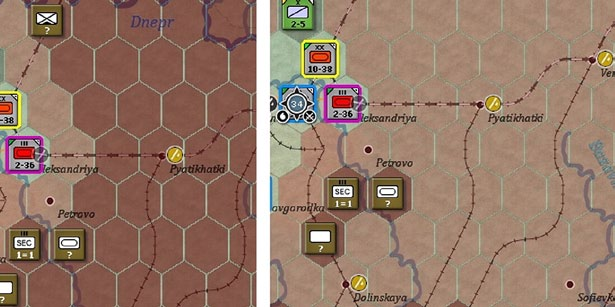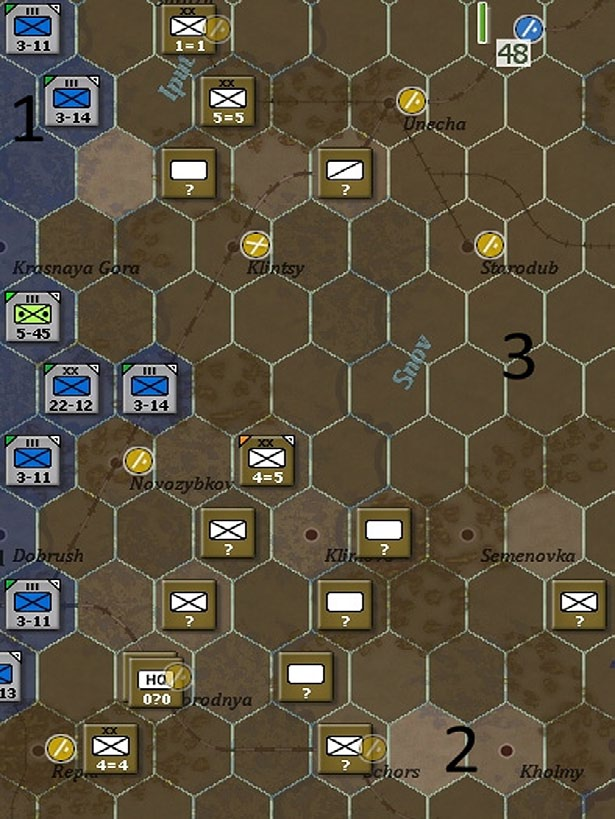10. Fog of War (FOW) and Enemy Unit Detection Level (DL)
Focus: This section provides more information on the impact of Fog of War and Detection on WiTE2.
Key Points:
- The concept of ‘Movement’ Fog of War in the game set up options
- How Detection Levels vary over time
- How Detection Levels affect Fog of War
10.1 Setting Fog of War off
Either when setting the game up (2.3) or later (if playing against the AI), the player(s) can opt not to use the Fog of War (FOW) rules either just for unit detection or for unit movement.
10.1.1 No Fog of War and Unit Detection
In this case all enemy units are visible on the map with accurate information on type, name, size and combat value included in the hex pop-up information. The Detection Level of each unit is still computed and impacts the combat effectiveness of any attacks against those units, but the location of all enemy units is known to the player (including those that would otherwise have a detection level of zero).
10.1.1 Movement Fog of War
The Fog of War options enable you to set the impact on movement separately to that on unit detection.
If you enable the basic FOW rules (i.e. some units cannot be seen and others will only show partial information) then you need to decide whether you will also use movement FOW or not.
With FOW on, unless there is an unbroken enemy front line, this option allows the player to see hexes behind enemy lines that do not contain enemy units up to the limit of the selected units allowed movement.
To offset this, if movement FOW is enabled, the show movement path and show movement allowed preferences will only display movement options to hexes if the movement path could be traced via friendly/pending friendly hexes or to hexes adjacent to friendly/pending friendly hexes (7.3).
Movement FOW takes away an “enhanced recon” feature caused by the nature of the movement system, but at a cost in play time. Basically, you will have to make an increased number of shorter moves when using move FOW as you won’t be allowed to move far into enemy territory. Ultimately your unit can cover the same ground, but with more mouse clicks and more individual moves. Also, it won’t be as easy to determine the fastest path to an enemy hex deep in enemy territory.
The example below shows how this can alter gameplay.

On the left hand side is the map with movement Fog of War enabled. When the German 2-36 Panzer regiment is selected information is only available about the current front line hexes and those are known to be Soviet controlled but not contain any Soviet units. Moving that regiment eastwards will slowly uncover more information about occupied or unoccupied hexes.
On the right hand side, movement Fog of War has been disabled and it is now clear where there are Soviet units behind the front line. In this case, the German unit could move towards Dnepropetrovsk without encountering any Soviet formations.
10.2 Detection Level (DL)
If you opt to use the Fog of War rules then the concept of the Detection Level (DL) is critical. Detection level (DL) is the determination of how much information is known about on-map enemy units. The higher the detection level, the more information is known and the more effective attacks will be on that unit.
10.2.1 Changes in Detection Levels
Each unit on the map, as well as attached support units, is automatically assigned a detection level from zero to ten, based on factors such as distance from enemy units, covering terrain and the results of air reconnaissance.

This shows how varying Detection Level affects the knowledge of enemy units. If there is no reconnaissance and the unit has not been in previous contact, then it is likely it will not be shown at all. Beyond that (1) is an example of a unit with low detection values, (2) has a higher value (enough to know it is a tank formation), (3) is known to be a rifle division but there is another, unknown unit in the hex so the total combat value is unknown, and (4) is a unit with higher enough detection to provide a decent estimate as to its cv. See section 10.2.7 below for information as to how this information relates to the DL for a given hex.
Unit detection levels will change over time and can be influenced by player actions. During the logistics phase, an airbase unit will have its DL decline by one, while non-airbase units will have their DL decline by Die (5). The DL levels of enemy combat units that are adjacent may then be increased as adjacent enemy combat units compare scouting values for the different units to determine changes in DL levels.
In addition, every time a unit moves next to an enemy unit, the enemy’s DL will usually go up due to automatic scouting and probing attacks. Losses from these scouting and skirmishing actions are represented by higher attrition levels for adjacent enemy units. Combat against enemy units will also increase their DL.
The DL of units that move away from the enemy will decrease over time.
10.2.2 Detection Levels and Combat
A higher detection level will increase the effectiveness of ground and air combat against that unit. The hex pop-up text will display detection levels for on-map units, to include construction support units and Anti-aircraft support units attached to cities.
Note this will occur even if FOW is turned off. In other words you can see the unit on the map but the scope to be surprised in combat, due to a low detection level, remains.
10.2.3 Raising Detection Levels by Air Reconnaissance
If you fly tactical reconnaissance missions you can raise the detection levels in the hex.
For non-air base units, air reconnaissance can raise detection levels up to a maximum of four with the following limits:
- Maximum Detection level 1: Non-Air base units located in non-clear terrain further then 3 hexes from supplied enemy units.
- Maximum Detection level 2: Non air base units located in non-clear terrain and not adjacent to enemy units.
- Maximum Detection level 4: Non-air base units located in clear terrain
Air reconnaissance can raise the DL of air base units up to the maximum of 10, if the airfield recon mission is chosen (18.1.6).
The Show air recon levels button (Shift-t) in the map information tool bar (6.2) will graphically display the level of air recon coverage with the lighter the shade in the hex, the better the air recon level. The actual numerical air recon level is listed in the hex pop-up.

This has the air reconnaissance map mode enabled. Blue hexes (1) are Axis controlled, light brown hexes (2) are Soviet controlled with some degree of Axis air reconnaissance and dark brown (3) are Soviet controlled without Axis air reconnaissance. Note, in this case, the units are still detected even if they are in a hex that has not been recently covered by an air reconnaissance mission.
If an air group is set to run a ‘unit’ reconnaissance mission (18.1.6) it will initially focus on raising the DL of already identified units, if this reaches the maximum feasible it will shift to trying to spot unidentified units (interdiction recon). So the choice of target has some bearing on whether your recon assets will focus on known formations or seeking to find unidentified ones.
10.2.4 Impact of Strategic Air Reconnaissance Missions
Strategic air reconnaissance only affects knowledge about the chosen targets (factories, manpower etc) in the city hexes reconnoitred.
Strategic reconnaissance will only target town, city and urban hexes while normal air recon can target any hexes and raises the Detection level of the hexes which in turn increase the DL of the units there.
When FOW is on, each time an enemy factory is bombed a picture is taken of those factories and an estimate of damage is made. When determining what factory to fly a strategic bombing mission against, the computer will use the FOW damage values. This means that a target that is thought to be heavily damaged will be less likely to be bombed, and it’s the fogged up damage level that is used.
10.2.5 Reconnaissance Missions and Other Air Missions
The interaction of reconnaissance and tactical air missions is discussed in sections 17.1 and 17.4. For the moment, note that it is useful to make the reconnaissance mission focus on the chosen target for a ground attack (tactical) or strategic bombing mission in order to improve the quality of any air attacks.
10.2.6 Detection Level and Naval Missions
Units utilizing naval and amphibious transport that remain at sea can have their detection levels raised by enemy naval interdiction in their water hex. Detection levels for units in water hexes are checked at the end of the logistics phase and at the end of the air execution phase.
To preserve FOW, during the amphibious invasion phase and air planning phase of an AI player turn, units will not be shown on the map. In addition, during multiplayer and PBEM, the map is blacked out during the amphibious phase.
10.2.7 Impact of Different Detection Levels
At the lowest level (0) you will not even be aware an enemy unit is in the hex. As the Detection Level increases you will be provided with more information about the unit but note that completely accurate combat values (CV) may not be displayed even at the highest detection level, and the potential size of the error increases as the DL number decreases.
The different detection levels are:
- Detection Level 1: The unit counter will be blank. A unit with detection level less than 3 won’t show its nationality counter colour. In this case it will be displayed with the generic Axis/Soviet colour.
- Detection Level 3: The Unit type will be displayed.
- Detection Level 5: The Unit name, unit size and CV will be displayed. Enemy units that start adjacent to friendly units will have a minimum DL of 5. Note that Unit counters will only display SS / Elite / LW / Guards status (colouring) if their detection level is 5 or greater.
- Detection Level 7: Soft factors can be observed (6.5.11).
The DL also influences the type of information you have about Support Units, Flak levels, enemy air operations, the effect if more than one enemy unit is in the hex and knowledge about enemy fortifications.
Support Units: Support units attached to cities, HQ units and ground units have detection levels in the same manner as on map units as their DL increases. In effect, their strength is added to the information displayed (or not) about other units in the hex.
Flak Levels: When FOW is enabled, flak values displayed on the map will be less accurate if the hex has a lower detection level.
Air Operations: Detection will affect your knowledge of the enemy air force and operations in various ways:
- Air Base Units: When FOW is enabled, the lower the detection level, the information will be less accurate in the hex pop-up text regarding enemy Air Groups located at the airfield. The accuracy of any damage report will also vary with the detection level.
- Air Mission Graphics: The graphic display (18.4) of any enemy interception and ground support missions, during the air directive resolution phase, on the map area will only show the direction the enemy Air Groups came from, not the entire line back to the air base unit they flew in from when FOW is enabled.
Stacked Units: When FOW is enabled, no CV/MP numbers will be printed on an enemy counter if there is no unit with a detection level greater than 4 in the stack. If there are units with DLs both greater than four and four or less in a stack, numbers will be printed, and a ‘?’ will be printed instead of the – or = between the numbers to indicate that in addition to the estimated CV strength in the hex, there are units of unknown strength in the hex. If the top unit in the stack has a DL of 1 or 2, a blank unit type box will appear on the top unit counter to indicate it is of an unknown type.
Enemy Fortification Levels: When FOW is enabled, information on enemy fortification levels (20.1) will only be displayed for hexes that are adjacent to a friendly unit or for hexes that contain a detected enemy unit with a DL of at least three.
10.2.8 Fog of War and AI Movement
When the AI is moving, if FOW is on then you will only see enemy units that are adjacent to your units. Once the movement phase is complete, the standard detection rules are used again.
10.2.9 Fog of War and Rail Damage/Usage
If FOW is on, then a hex will not show either rail damage or usage for enemy hexes unless you have sufficient detection level.